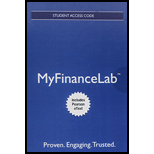
MyLab Finance with Pearson eText -- Access Card -- for Corporate Finance (Myfinancelab)
4th Edition
ISBN: 9780134099170
Author: Jonathan Berk, Peter DeMarzo
Publisher: PEARSON
expand_more
expand_more
format_list_bulleted
Concept explainers
Textbook Question
Chapter 23, Problem 4P
Suppose venture capital firm GSB partners raised $100 million of committed capital. Each year over the 10- year life of the fund, 2% of this committed capital will be used to pay GSB’s management fee. As is typical in the venture capital industry, GSB will only invest $80 million (committed capital less lifetime management fees). At the end of 10 years, the investments made by the fund are worth $400 million. GSB also charges 20% carried interest on the profits of the fund (net of management fees).
- a. Assuming the $80 million in invested capital is invested immediately and all proceeds were received at the end of 10 years, what is the
IRR of the investments GSB partners made? That is, compute IRR ignoring all management fees. - b. Of course, as an investor, or limited partner, you are more interested in your own IRR-that is, the IRR including all fees paid. Assuming that investors gave GSB partners the full $100 million up front, what is the IRR for GSB’s limited partners (that is, the IRR net of all fees paid).
Expert Solution & Answer
Want to see the full answer?
Check out a sample textbook solution
Students have asked these similar questions
1) Assume a VC firm raised $6B in committed capital for a 10-year investment fund. Each year, 2% of the committed capital will go to management fees, or 20% total. The remaining 80%, or $4.8B, will be invested in start-up firms. The firm also charges 20% carried interest on the profits of the fund.
Assume the fund is worth $77.6B at the end of 10 years. What is the annual IRR based on the $6B initial investment? This is what the investors earned, after expenses. Note that you must take out the carried interest to find out the amount that goes to the investors.
2) A firm needs to raise $474.2 million in its IPO to fund its next investment project. The flotation costs (aka underwriting fees) are equal to 7%. How much does the firm need to raise so that they are left with the amount they need after flotation costs?
3)
Determine how many new shares of stock would need to be sold in an IPO with the following characteristics:
Pre-IPO valuation: $2 billion
Number of existing shares…
Chapter 23 Solutions
MyLab Finance with Pearson eText -- Access Card -- for Corporate Finance (Myfinancelab)
Ch. 23.1 - Prob. 1CCCh. 23.1 - Prob. 2CCCh. 23.2 - Prob. 1CCCh. 23.2 - Prob. 2CCCh. 23.3 - List and discuss four characteristics about IPOs...Ch. 23.3 - Prob. 2CCCh. 23.4 - Prob. 1CCCh. 23.4 - What is the average stock price reaction to an...Ch. 23 - Prob. 1PCh. 23 - What are the advantages and the disadvantages to a...
Ch. 23 - Prob. 3PCh. 23 - Suppose venture capital firm GSB partners raised...Ch. 23 - Prob. 5PCh. 23 - Prob. 6PCh. 23 - Prob. 7PCh. 23 - Prob. 8PCh. 23 - Prob. 9PCh. 23 - Prob. 10PCh. 23 - Prob. 11PCh. 23 - Prob. 12PCh. 23 - What is IPO underpricing? If you decide to try to...Ch. 23 - Prob. 14PCh. 23 - Prob. 15PCh. 23 - Prob. 16PCh. 23 - Prob. 17PCh. 23 - Prob. 18PCh. 23 - Prob. 19PCh. 23 - Prob. 20P
Knowledge Booster
Learn more about
Need a deep-dive on the concept behind this application? Look no further. Learn more about this topic, finance and related others by exploring similar questions and additional content below.Recommended textbooks for you
 EBK CONTEMPORARY FINANCIAL MANAGEMENTFinanceISBN:9781337514835Author:MOYERPublisher:CENGAGE LEARNING - CONSIGNMENT
EBK CONTEMPORARY FINANCIAL MANAGEMENTFinanceISBN:9781337514835Author:MOYERPublisher:CENGAGE LEARNING - CONSIGNMENT
 Cornerstones of Cost Management (Cornerstones Ser...AccountingISBN:9781305970663Author:Don R. Hansen, Maryanne M. MowenPublisher:Cengage Learning
Cornerstones of Cost Management (Cornerstones Ser...AccountingISBN:9781305970663Author:Don R. Hansen, Maryanne M. MowenPublisher:Cengage Learning

EBK CONTEMPORARY FINANCIAL MANAGEMENT
Finance
ISBN:9781337514835
Author:MOYER
Publisher:CENGAGE LEARNING - CONSIGNMENT


Cornerstones of Cost Management (Cornerstones Ser...
Accounting
ISBN:9781305970663
Author:Don R. Hansen, Maryanne M. Mowen
Publisher:Cengage Learning

Capital Budgeting Introduction & Calculations Step-by-Step -PV, FV, NPV, IRR, Payback, Simple R of R; Author: Accounting Step by Step;https://www.youtube.com/watch?v=hyBw-NnAkHY;License: Standard Youtube License